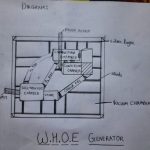

Science Project: A Spark of Clean Energy
W.H.O.E Generator ( Water to Hydrogen and Oxygen to Energy Generator)
A generator that can help us fight against global warming. It is not only a generator but can be used in multiple ways which can benefit us. It doesn’t use fossil fuels or other pollutant, the fuel can be found anywhere, which is….. WATER!! A non polluting, easily accessible and cost effective fuel. The generator doesn’t produce any by-products. Thus very effective for our lifestyle and world. It can replace the fossil fuel engines in vehicles. The main use of such energy generator is in the transport industry.
Problems addressed:
Global warming
Fuel shortage
Efficient power source
Fuel accessibility
High costs.
The Basic Working:
The system uses water which is split into hydrogen and oxygen, then these gases are combusted and as hydrogen is a very efficient fuel it can replace petroleum fuels. It produces water on combustion and this water is cooled to form liquid. This water is split again into water and the cycle is repeated.
Parts:
1. The Electrolysis Chamber:
Water is split into hydrogen and oxygen using electrolysis in this chamber and then the gases passes into the 2nd part.
In this chamber, water is present in liquid form and as the name suggests electrolysis is performed here.
Electric circuits pass through the vacuum chamber into this chamber which passes electric current through the liquid and splitting it into it’s constituent components, hydrogen and oxygen.
These products are passed into the combustion chamber through sealed pipes.
The combustion chamber is connected back to this chamber so water flows back (this water obtained is not additionally added but formed during combustion) using pipes and cooling systems.
2. The Combustion Chamber:
Hydrogen and oxygen are combusted to form energy and water in this chamber and the products are passed to the conversion chamber and back to electrolysis chamber.
In this chamber, the gases formed in the electrolysis chamber are combusted as the name suggests to produce energy and water.
The gases are brought to this chamber through pipes connecting this chamber and the electrolysis chamber.
The combustion takes place here but as hydrogen is inflammable gas the heat control system and the blast reducing walls of this chamber control the explosion and limit it from existing the chamber and also the combustion is conducted in small scale to limit blast power.
The product obtained in the process, energy is used in obtaining electrical energy or mechanical energy which is conducted in the conversion chamber.
And the other product, water is supplied back to the electrolysis chamber, and the cycle continues.
3. The Conversion Chamber:
Here the heat energy from the combustion chamber is converted to electrical energy to be used for many purposes.
There are 2 types of conversion chambers, mechanical and electrical.
The 1st type of this such chamber converts the thermal energy derived from combustion of hydrogen and oxygen in the combustion chamber to mechanical energy.
In this system, the thermal energy is used to heat up a gas in a sub-chamber which pushes on a piston in the sub-chamber, this piston in turn moves and rotates gears, then it is pulled back to original position by cooling the gas, thus rapid movement of this piston causes the gears to turn quickly and produces mechanical energy which can be used for many purposes.
The 2nd type of chamber converts the thermal energy to electrical energy.
In this system, the thermal energy is extracted and converted to electrical energy using a heated substance, which is obtained by heating the substance using the thermal energy derived from the combustion chamber or using the heated product of the combustion which is H2O.
The energy is converted into electricity by using a simple circuit which has one end inserted in the hot substance and the other end in a cold substance.
As the heat passes through the circuit the thermal energy gets converted to electrical energy which can be used for many purposes in the vehicle for instance to run the motors to rotate the tires of the vehicle.
4. Heat Control System:
Vacuum and silver lined chamber, and cooling pipe system for reducing over-heating problems.
Surrounding the electrolysis and combustion chamber is a chamber of cool vacuum or emptiness and walls of with silver coating to control the heat transmission.
This system is for preventing transmission of excess heat to outside the entire generator.
As there are 3 ways of transmission of heat we know, conduction, convection and radiation, thus to control all possible ways of transmission:
- Conduction is controlled by the vacuum chamber.
- Convection is also controlled by the vacuum.
- Radiation is handled by the silver lined walls
Another part of the system is the cooling pipe system which keep the engine cool ,and cool and condense the water formed during the combustion process after the energy is extracted (depending on generator type)
Basically the entire system is based on the topic of heat control.
5. Additional Parts:
-
Pipes, Strong building material, Stands, etc.
- This system includes all of the secondary builds of the entire generator:
The pipes: the pipes are made of strong materials like iron and polycarbonates. The iron provides the strength and heat persistence and the polycarbonates prevent the heat transmission to surroundings
- This system includes all of the secondary builds of the entire generator:
-
Walls of the chambers:
- the walls have 3 layers, 1st layer(innermost) of iron to provide strength and heat persistence; 2nd layer(middle) of a strong insulting material to provide a strong structure and prevention of heat transmission and 3rd layer(outermost) of iron again to support the 2nd layer. But in case of the combustion chamber walls, the 1st layer is made of tungsten as it has a high melting point.
The input pipe: the input pipe is for inserting more water into the electrolysis chamber.
- the walls have 3 layers, 1st layer(innermost) of iron to provide strength and heat persistence; 2nd layer(middle) of a strong insulting material to provide a strong structure and prevention of heat transmission and 3rd layer(outermost) of iron again to support the 2nd layer. But in case of the combustion chamber walls, the 1st layer is made of tungsten as it has a high melting point.
-
Stands:
- stands connect the the chambers to the walls of the vacuum chamber. They are made of a strong insulating material. These also have wire and other circuit components connected to them.
Walls of the vacuum chamber: the vacuum chamber walls are the outer most part of the entire project thus are made of 3 layers, 1st layer(innermost) is made of silver for heat radiation reflection, 2nd layer(middle) of iron for a strong structure and 3rd layer(outermost) of polycarbonates or strong thermosetting plastics.
- stands connect the the chambers to the walls of the vacuum chamber. They are made of a strong insulating material. These also have wire and other circuit components connected to them.
Possible Uses:
- Vehicle engines.
- Power production mechanism for large scale power plants.
- Power sources for machines and projects.
- A system with only production of thermal energy or a system without the conversion chamber can be used for household purposes like cooking instead of using a LPG using stove.
- Can also be used in scientific research as a more reliable heating mechanism using the above system.
- And much more…..
Conclusion:
The generator is a cost-effective, efficient and eco-friendly power source. The fuel used is easily available and cheap. The fuel is reused and gets used up over a long period of time. Thus, making it very easy to utilise the generator. The generator does weigh in its regular size and can be used as a portable power source or in light vehicles. It can be used for multiple purposes and thus it is very useful.
Curious Times is a leading newspaper and website for kids. We publish daily global news aligned to your learning levels (also as per NEP 2020): Foundational, Preparatory (Primary), Middle and Senior. So, check out the News tab for this. We bring kids’ favourite Curious Times Weekly newspaper every weekend with top news, feature stories and kids’ contributions. Check out daily JokesPoke, Tongue Twisters, Word of the Day and Quote of the Day, kids need it all the time.
ME – My Expressions at Curious Times is your place to get your work published, building your quality digital footprint. And it is a good way to share your talent and skills with your friends, family, school, teachers and the world. Thus, as you will step into higher educational institutes your published content will showcase your strength.
Events, Quizzes and Competitions bring students from over 5,000 schools globally to participate in the 21st-Century themes. Here schools and students win certificates, prizes and recognition through these global events.
Sign-up for your school for FREE!
Communicate with us: WhatsApp, Instagram, Facebook, Youtube, Twitter, and LinkedIn
0 (Please login to give a Curious Clap to your friend.)
SignUp to Participate Now! Win Certifiates and Prizes.


Login/Signup